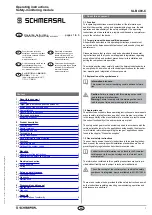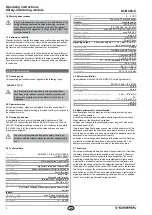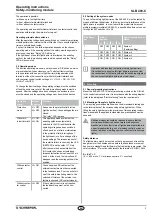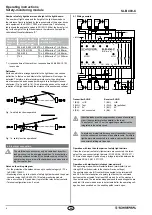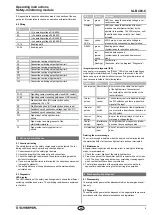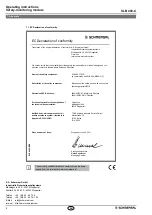
3
SLB 400-C
Operating instructions
Safety-monitoring module
EN
The operation is possible:
• with one up to four light barriers
• with or without start/restart interlock and
• with or without contactor control
The operating modes with start/restart interlock, contactor control and
operation with two light barriers are factory set.
Operating principle after switch-on
After the operating voltage has been switched on, the safety-monitoring
module performs an internal self-test. After that, the connected light bar-
riers are activated and tested.
If no fault is detected, the further operation depends on the chosen
operating mode. If the enabling paths of the safety-monitoring module
are closed, the green "Relay" LED will be on.
If the light beam of a safety light barrier is interrupted, the enabling
paths of the safety-monitoring module will be opened and the "Relay"
LED will become red.
2.8 Operating modes
The desired operating modes are set by means of DIP switches, which
are located below the enclosure cover. The default factory setting
is the operation with one pair of light barriers (bridge between the
terminals of the other connections), with start/restart interlock and
with contactor control (switch settings: J1 = ON, J2 = ON, J3 = ON,
J5=J6=J7=J8=OFF).
To change the basic settings, the operating voltage must be switched
off and the enclosure cover of the safety-monitoring module must be
opened. After the settings have been changed, the enclosure cover
must be closed and the operating voltage must be switched back on.
Operating
mode
switch-
position
Function
Protective
mode
J1=OFF,
J2=OFF
As soon as the protective field is free
(light beam free), the enabling paths are
closed.
The "relay" LED is green.
With start-/
restart interlock
J1=ON,
J2=ON
This operating mode avoids that the
enabling paths are automatically
switched to the ON condition after the
operating voltage has been switched
off and back on or after an intervention
in the protection field (interruption of
the light beam) or after a change of the
device settings. The release request of
the restart interlock is shown by the LED
(RESTART) and the output Y1. Only
after the command device/start button
(NO contact) has been actuated and
released (actuation time at least 250 ms
and 5 s at the most), the indication will
disappear and the enabling paths will be
enabled.
With contactor
control
J3=ON
The series-wired NC contacts of the
external contactors must be connected
to the feedback loop. Prior to each start-
up of the safety-monitoring module, the
switched-off status of the external con-
tactors is checked (NC contact closed).
Without contac-
tor control
J3=OFF
If the contactor control is not required,
the feedback loop must not be con-
nected.
2.9 Setting of the system codes
The up to four safety light barriers of the SLB 400-C must be tested by
means of different bit patterns. In this way, a mutual interference of the
light barriers is excluded. In order to avoid the mutual interference of
multiple systems (multiple SLB 400-C), a specific bit pattern set can set
through the DIP switches J5 to J8.
Bit pattern
set
switch-
position
Operational behaviour/
Notes
J5
J6
J7
J8
1
OFF OFF OFF OFF System 1
(Factory setting)
2
OFF ON
OFF ON
System 2
3
ON
OFF ON
OFF System 3
4
ON
ON
ON
ON
System 4
Operation with less than four pairs of safety light barriers
If less than four pairs of safety light barriers are connected,
the connections of the test inputs and the switching outputs of
the non-connected light barriers must be bridged.
3. Mounting
3.1 General mounting instructions
Mount the SLB 400-C10-1R safety-monitoring module on the DIN rail
in the control cabinet and wire it in accordance with the wiring diagram
(refer to the paragraph "Electrical wiring") and the requirements.
3.2 Mounting of the safety light barriers
The mounting possibilities are shown on the dimensional drawing and
in the techical data of the corresponding safety light barrier. When
fitting the safety light barriers, the provisions of this operating instruc-
tions manual and the applicable standards and prescriptions must be
observed.
Additional measures could be required to ensure that the
electro-sensitive device does not present a dangerous
breakdown, when other forms of light beams are available in
a special application (e.g. use of wireless control devices on
cranes, radiation of welding sparks or effects of stroboscopic
lights).
Safety distance
The light barriers must be mounted so that a person cannot reach the
danger point or the hazardous area before the hazardous movement
has come to standstill and furthermore that tampering is prevented. The
safety distance "S" must be calculated to the formula of EN ISO 13855.
S = K x T + C
(K = 1,600 mm/s, T = total response time, C = constant)

